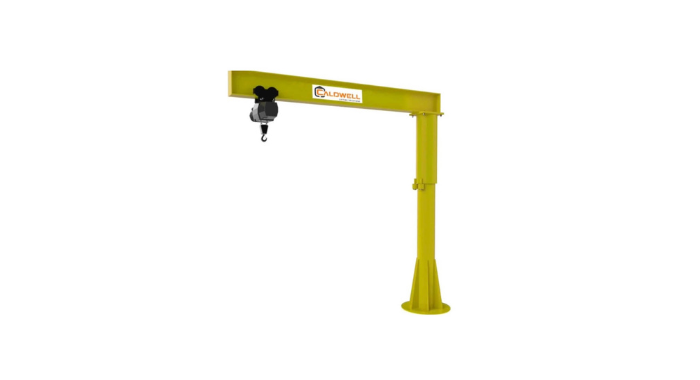Caldwell Explains Rise of Foundationless Jibs
The Caldwell Group Inc. is pioneering increased utilization of foundationless jib cranes.
As part of ongoing outreach campaigns, the Rockford, Illinois-based manufacturer of lifting and other material handling equipment has penned a white paper, titled ‘Foundationless Jibs Enjoy Popularity Rise’, outlining how the technology proves its worth in the 1-ton capacity range across a multitude of applications.
There was a time when the mention of a jib crane installation of any capacity conjured up images of long consultations with architects and structural engineers, even before ripping up the floor, digging foundations, and installing the product. Those days seem to be a thing of the past, which is a message Caldwell is driving through its channel partners.
Darrin Noe, director of sales at Caldwell and author of the well-read white paper, said: “Foundationless jibs are a type of freestanding jib, but they don’t require a special poured foundation. More than that, they can be installed almost anywhere in a workplace that conforms to a manufacturer’s guidance. There’s no need to worry about the 3 ft.- or 4 ft.-deep reinforced foundations that are nearly always required with alternative solutions. Foundationless jibs are different in that they have a larger diameter base plate and additional ‘upright material’, as one distributor put it to me recently—to help relocate the forces.”
Foundationless jib cranes are generally reserved for a lower capacity. For example, the Caldwell-branded models are available in ½-ton and 1-ton capacities only. The ½-ton version has a maximum span of 20 ft. and height under boom (HUB) of 20 ft., while the 1-ton version has a maximum span of 16 ft. and maximum HUB of 16 ft. This suits them to a breadth of application—without ever having to dig deep foundations and make a crane a permanent fixture within a facility.
“That’s a point worth reiterating,” Noe wrote, “Because the production flow of a warehouse, production, or manufacturing facility varies greatly, even week-to-week. It might be that a crane is only required in a certain place at a specific capacity for a period. If the 3 ft.- or 4 ft.-deep reinforced foundations we’ve spoken about house the jib crane, it’s not a tool that can be easily removed, and certainly not worth relocating if its new workstation might turn out to be just as temporary.”
Foundationless jib cranes are also becoming more popular because they now come with a much more comprehensive turnkey package, with all components included in the price of the crane. There’s no longer a need to go out and shop for the parts separately, particularly if an end user is working with a reputable manufacturer, like Caldwell, and one of its world-class dealers. They can now get a foundationless jib crane, tag line kit, special anchoring bolts, two-part epoxy—and even an epoxy gun—in one shipment.
Noe said: “Generally, we’ve monitored increased uptake through single-crane orders, which isn’t a surprise given the capacity and application situations we’ve spoken about, but we have had orders where a customer will be outfitting a new plant or new portion of his / her facility and these solutions emerge at the top of their material handling order list. That said, the marketplace will remain for low-unit, commodity, quick shipment-style acquisitions.”
Read the white paper, ‘Foundationless Jibs Enjoy Popularity Rise’, here.


